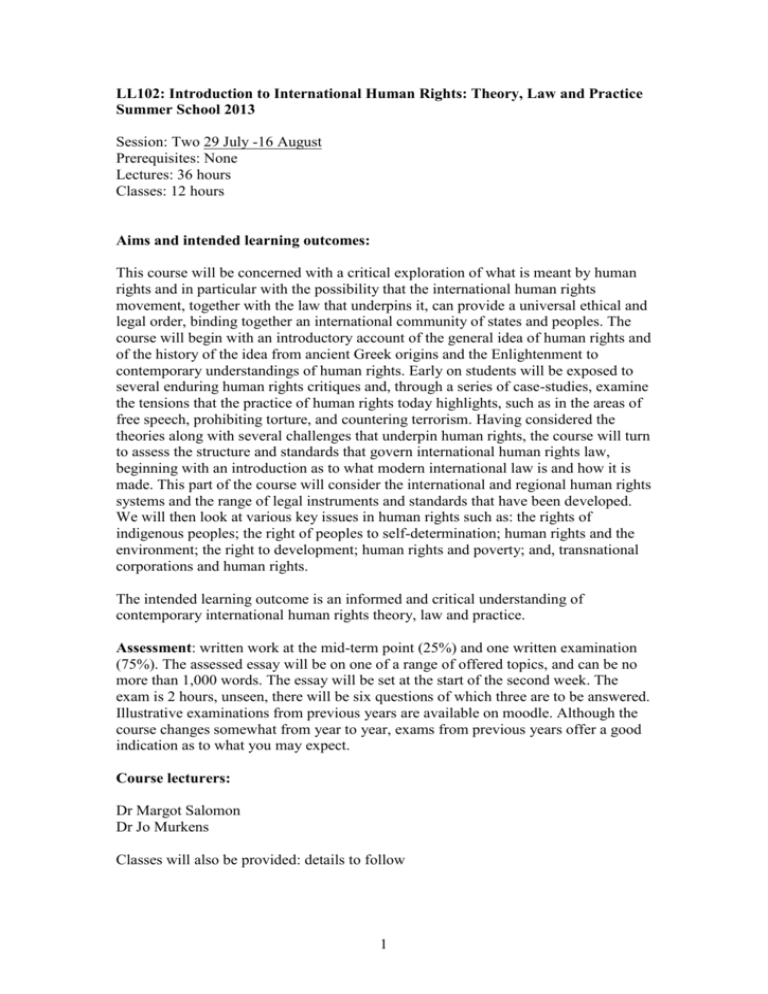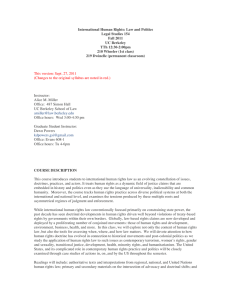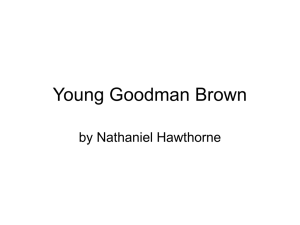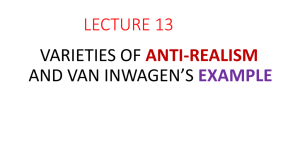LL102: Human Rights: Theory, Law and Practice
advertisement

LL102: Introduction to International Human Rights: Theory, Law and Practice Summer School 2013 Session: Two 29 July -16 August Prerequisites: None Lectures: 36 hours Classes: 12 hours Aims and intended learning outcomes: This course will be concerned with a critical exploration of what is meant by human rights and in particular with the possibility that the international human rights movement, together with the law that underpins it, can provide a universal ethical and legal order, binding together an international community of states and peoples. The course will begin with an introductory account of the general idea of human rights and of the history of the idea from ancient Greek origins and the Enlightenment to contemporary understandings of human rights. Early on students will be exposed to several enduring human rights critiques and, through a series of case-studies, examine the tensions that the practice of human rights today highlights, such as in the areas of free speech, prohibiting torture, and countering terrorism. Having considered the theories along with several challenges that underpin human rights, the course will turn to assess the structure and standards that govern international human rights law, beginning with an introduction as to what modern international law is and how it is made. This part of the course will consider the international and regional human rights systems and the range of legal instruments and standards that have been developed. We will then look at various key issues in human rights such as: the rights of indigenous peoples; the right of peoples to self-determination; human rights and the environment; the right to development; human rights and poverty; and, transnational corporations and human rights. The intended learning outcome is an informed and critical understanding of contemporary international human rights theory, law and practice. Assessment: written work at the mid-term point (25%) and one written examination (75%). The assessed essay will be on one of a range of offered topics, and can be no more than 1,000 words. The essay will be set at the start of the second week. The exam is 2 hours, unseen, there will be six questions of which three are to be answered. Illustrative examinations from previous years are available on moodle. Although the course changes somewhat from year to year, exams from previous years offer a good indication as to what you may expect. Course lecturers: Dr Margot Salomon Dr Jo Murkens Classes will also be provided: details to follow 1 Primary Texts: All students should buy S Ghandhi (ed.), Blackstone’s International Human Rights Documents, (8th edition, Oxford University Press, 2012). Then students should buy either H J Steiner, P Alston & R Goodman, International Human Rights in Context: Law, Politics, Morals, (3rd edition, Clarendon Press, 2008). or R K M Smith, Texts and Materials on International Human Rights, (2nd edition, Routledge, 2010). Secondary Texts: J Donnelly, Universal Human Rights in Theory and Practice, (2nd edition, Cornell University Press, 2003). M Freeman, Human Rights: An Interdisciplinary Approach, (2nd edition, Polity, 2011). R Smith, Textbook on International Human Rights, (2nd edition, Oxford University Press, 2005). Two very useful books are: S Marks and A Clapham, International Human Rights Lexicon (Oxford University Press, 2005). A Clapham, Human Rights: A Very Short Introduction (Oxford University Press, 2007). Further reading: see below for annexes attached to this reading list. The first provides helpful websites and the second offers a further reading list. Course structure This course is divided into three parts, covering twenty-three themes in the course of twelve three-hour lectures. The reading for each theme is included alongside the theme. 2 PART ONE: THEORIES AND HISTORIES OF HUMAN RIGHTS Lecture one - Introduction: the course lecturers set out the nature of the course and explain its structure, logic, and content. - The history of the emergence of human rights as an idea: Greek beginnings; respect for human dignity and human flourishing; the origins of human rights in the emergence of the rule of law; the Church and natural law; Hobbes, Locke, Pufendorf; the English revolution of 1688; three generations of human rights. o Donnelly, Universal Human Rights in Theory and Practice, Ch.1 o Freeman, Human Rights: An Interdisciplinary Approach, Ch. 2 Lecture two - Human rights after the Enlightenment: Kant and the construction of a new cosmopolitan ethic; Hegel and rights; their contemporary incarnations. o Steiner, Alston and Goodman, International Human Rights in Context 475-516 o Freeman, Ch. 4 - The universality of human rights: o Lord Steyn, ‘Human Rights: The Legacy of Mrs Roosevelt’, Public Law (2002) 473-484 o Steiner, Alston and Goodman, 517-540 - Human rights critiques: Bentham; Marx o Freeman, Ch. 4 - Non-Western critiques of human rights: o Steiner, Alston and Goodman, 517-540 o Donnelly, Ch. 5 Lecture three - The move to contemporary ‘human rights’ from those (western) beginnings – civil liberties – civil and political rights. - International law and human rights: background, politics and values. Human rights as subversive of traditional international law o Donnelly Ch. 2 o Steiner, Alston and Goodman, 115-148 o Freeman, Ch. 3 - The sovereignty critique: the continuing power of the nation state, originally hostile to human rights: are traces of this hostility left? 3 o Steiner, Alston and Goodman, 669-734 Lecture four: - Human rights and human rights challenges: the practice/case studies – historical values in contemporary society, tensions: o freedom of expression - hate speech; E Heinze, ‘Wild-West Cowboys versus Cheese-Eating Surrender Monkeys’ in J Weinstein and I Hare (eds), Extreme Speech and Democracy (2009). o prohibition on torture; Steiner, Alston and Goodman, 224-250 o war on terror J Waldron, ‘Security and Liberty: The Image of Balance’ 11 Journal of Political Philosophy (2003) 191. K Gunther, ‘World Citizens Between Freedom and Security’ 12 Constellations (2005) 379. PART TWO: STRUCTURES AND STANDARDS Lecture five - What is international law for and how is it made? Where does the branch of international human rights law fit into this scheme and what are its particularities? o P Sieghart, The Lawful Rights of Mankind (1985) Ch. 5 (Modern Human Rights Law) o Sieghart, Ch. 6 (Making International Law) Instrument o United Nations Charter, Arts. 1 and 2. Lecture six - International human rights standards: Examination of the use of treaties as instruments for engineering the development of human rights in international law. Lay out the classification of human rights treaties and categories of rights. Explore the nature of different generations of human rights and the corresponding obligations. Key concepts in human rights: universality, interdependence. o R Smith, Textbook on International Human Rights, 2nd edn. (2005) Ch. 4 o Sieghart, 103-168 (What the Code Says) o Freeman, Ch. 3 4 Instruments: The Universal Declaration of Human Rights and the 9 core UN human rights treaties o Universal Declaration of Human Rights (1948) o International Convention on the Elimination of All Forms of Racial Discrimination, 1965 (ICERD) o The International Covenant on Economic, Social and Cultural Rights, 1966 (ICESCR) o The International Covenant on Civil and Political Rights, 1966 (ICCPR) o Convention on the Elimination of All Forms of Discrimination Against Women, 1979 (The Women's Convention/CEDAW) o Convention against Torture and Other Cruel, Inhuman or Degrading Treatment, 1984 (The Torture Convention/CAT) o Convention on the Rights of the Child, 1989 (the Children's Convention/CRC) o International Convention on the Protection of the Rights of All Migrant Workers and Members of their Families, 1990 o Convention on the Rights of Persons with Disabilities 2006 (CRPD) o International Convention for the Protection of All Persons from Enforced Disappearance, 2006 Lecture seven - United Nations human rights system: principal organs, the treaty-bodies, the charter-based bodies, working methods, and implementation of standards. o Steiner, Alston and Goodman, 735-835; 844-895; 913-924 o Donnelly, 145-154 Lecture eight - Regional human rights systems: Europe, Americas, Africa, as well as, Arab states and ASEAN. o Steiner, Alston and Goodman, 925-1092 (Europe, Americas) o J Rehman, International Human Rights Law, 2nd edn (2010) Ch. 10 (Africa) o Smith, Texts and Materials on International Human Rights, 2nd edn (2010) 175-176 (Arab states; ASEAN) PART 3: KEY ISSUES IN HUMAN RIGHTS Lecture nine - Group rights: the rights of minorities and of indigenous peoples o Smith, Textbook on International Human Rights, Ch. 21 (minority rights) 5 o Smith, Texts and Materials, Ch. 12 (rights of indigenous peoples) Instruments o International Covenant on Civil and Political Rights (1966), Art.27 http://www2.ohchr.org/english/law/ccpr.htm o Convention on the Rights of the Child, Art. 30 (1989) http://www2.ohchr.org/english/law/crc.htm o The UN Declaration on the Rights of Persons Belonging to National or Ethnic, Religious and Linguistic Minorities (1992) http://www2.ohchr.org/english/law/minorities.htm o UN Declaration on the Rights of Indigenous Peoples (2007) http://www2.ohchr.org/english/law/index.htm#instruments Cases o Lovelace v Canada, Communication No. 24/1977, UN Doc CCPR/C/13/D/24/1977 (1984) http://www1.umn.edu/humanrts/undocs/html/24_1977b.htm o Chief Bernard Ominyak and the Lubicon Lake Bank v Canada Communication No. 167/1984, UN Doc CCPR/C/38/D/167/1984 (1990). Esp. paras. 32.1-33 http://www1.umn.edu/humanrts/undocs/session38/167-1984.html o Lansman et al v Finland, Communication No. 511/1992, UN Doc CCPR/C/52/D/511/1992 (1994). Esp. paras. 3.1-3.2 and 9.1-10. http://www1.umn.edu/humanrts/undocs/html/vws511.htm Lecture ten - An introduction to ‘3rd generation rights’: right to self-determination, the right to a clean environment, among others. o H Gros Espiell, ‘Community-Oriented Rights: Introduction’ in Mohammed Bedjaoui (ed), International Law: Achievements and Prospects (1991) 1167. - Self-determination o Smith, Textbook on International Human Rights, Ch. 17 (selfdetermination) o J Crawford, ‘The Right of Self-Determination in International Law: Its Development and Future’, in P Alston (ed), Peoples’ Rights (2001) 7. Instruments o International Covenant on Civil and Political Rights and International Covenant on Economic, Social and Cultural Rights (1966), common Art.1 o African Charter on Human and Peoples’ Rights, Arts. 20-24. http://www1.umn.edu/humanrts/instree/z1afchar.htm - Human rights and the environment 6 o D Shelton, ‘Human Rights, Health and Environmental Protection: Linkages in Law and Practice’, 1 Human Rights and International Legal Discourse 1 (2007) 9. Lecture eleven - Human rights and poverty o C Chinkin, ‘The United Nations Decade for the Elimination of Poverty: What Role for International Law?’ 54 Current Legal Problems (2001) 553. o Steiner, Alston and Goodman, 308-312 Instrument o International Covenant on Economic, Social and Cultural Rights. - Human rights and development o Steiner, Alston and Goodman, 1433-1453 o T Pogge, ‘The First United Nations Millennium Development Goal: A Cause for Celebration?’ 5 Journal of Human Development 3 (2004) 377. Reflections one, three and four. Instrument o Declaration on the Right to Development (1986). http://www2.ohchr.org/english/law/rtd.htm Lecture twelve - Non-state actors and human rights: o Transnational corporations and human rights Steiner, Alston and Goodman, 1387-1414 M Scheinin, ‘IOs and TNCs at a World Court of Human Rights’, 3 Global Policy, 4 (2012) 488. UN Special Representative (Ruggie), Guiding Principles on Business and Human Rights: Implementing the United Nations Protect, Respect and Remedy Framework http://www.ohchr.org/Documents/Issues/Business/A-HRC17-31_AEV.pdf o International non-governmental organisations Steiner, Alston and Goodman, 1420-1432. ANNEX I: HELPFUL WEBSITES 7 For links to online human rights materials, you may wish to consult: Full texts of international human rights instruments http://www2.ohchr.org/english/law/index.htm#instruments University of Minnesota, Human Rights Library http://www1.umn.edu/humanrts//index.html American Society of International Law – human rights www.asil.org/resource/humrts1.htm International Human Rights Lexicon www.internationalhumanrightslexicon.org The homepages of principal human rights organisations are: UN High Commissioner for Human Rights www.ohchr.org European Court of Human Rights www.echr.coe.int/echr Inter-American Commission and Court www.oas.org/OASpage/humanrights.htm African Commission on Human and Peoples’ Rights www.achpr.org African Court on Human and Peoples’ Rights http://www.african-court.org/en/ Amnesty International www.amnesty.org Human Rights Watch www.hrw.org Interights www.interights.org ANNEX II: SELECTED FURTHER READING 8 African Commission on Human and Peoples’ Rights, Report Working Group of Experts on Indigenous Populations/Communities (International Work Group for Indigenous Affairs, 2005). Available at: http://www.iwgia.org/ P Alston, ‘Ships Passing in the Night: The Current State of the Human Rights and Development Debate Seen Through the Lens of the Millennium Development Goals’, 27 Human Rights Quarterly (2005) 755. J Anaya, Indigenous Peoples in International Law (2nd edn, Oxford University Press, 2004). B A Andreassen and S P Marks (eds), Development as a Human Rights (2nd edn., Intersentia, 2010). A Cassese, International Law (Oxford University Press, 2005). A Clapham, Human Rights Obligations of Non-State Actors (Oxford University Press, 2006). R Dworkin, Taking Rights Seriously (Gerald Duckworth & Co, 1978). R Dworkin, ‘Rights as Trumps’ in J Waldron (ed), Theories of Rights (Oxford University Press,1984) . A Eide, and E-I. Daes, Working Paper on the Relationship and Distinction between the Rights of Persons Belonging to Minorities and those of Indigenous Peoples, UN Doc. E/CN.4/Sub.2/2000/10. H Gros Espiell, ‘Community-Oriented Rights: Introduction’ in Mohammed Bedjaoui (ed), International Law: Achievements and Prospects (Martinus Nijhoff, 1991) 1167. T Evans, The Politics of Human Rights: A Global Perspective ( Pluto Press, 2001). R Higgins, Problems and Process: International Law and How we Use It (Oxford University Press,1994). M R Ishay, The Human Rights Reader (Routledge, 1997) M R Ishay, The History of Human Rights. From Ancient Times to the Globalization Era (University of California Press, 2004) M T Kamminga and M Scheinin (eds) The Impact of Human Rights Law on General International Law (Oxford University Press, 2009) R Rorty, ‘Human Rights, Rationality and Sentimentality’ in S Shute and S Hurley (eds), On Human Rights (Basic Books, 1993) K Roth and M Worden (eds), Torture. Does It Make Us Safer? Is it Ever Ok? (The New Press, Human Rights Watch, 2005) 9 M E Salomon Global Responsibility for Human Rights: World Poverty and the Development of International Law (Oxford University Press, 2007) M Scheinin, Towards a World Court of Human Rights, Research report within the framework of the Swiss Initiative to commemorate the 60th anniversary of the Universal Declaration of Human Rights (2009). United Nations, International Cooperation at a Crossroads: Aid, Trade and Security in an Unequal World (UNDP Human Development Report, Oxford University Press, 2005). United Nations High-Level Panel, A More Secure World: Our Shared Responsibility. Report of the High Level Panel on Threats, Challenges and Change (UN Doc, A/59/565, December 2004). 10









